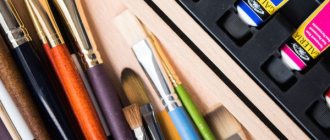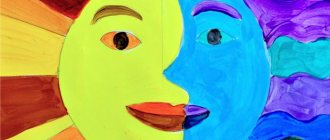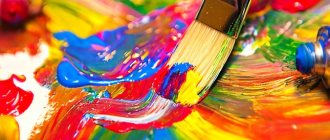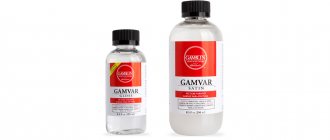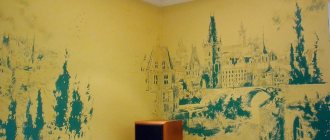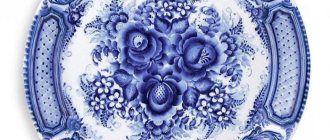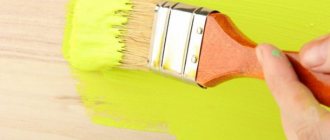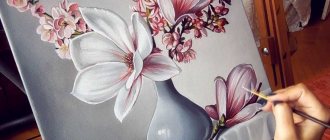Home page
About sculptural painting and our materials
First, the official definition : Sculptural painting is an artistic direction that combines elements of creating sculpture in terms of the working material - decorative plaster, and elements of painting in terms of the technique of working with a palette knife, close to the impasto technique, implying the creation of volumetric textures and elements by applying material to surface according to the principle of “one stroke – one element”.
: Sculptural painting is an artistic direction that combines elements of creating sculpture in terms of the working material - decorative plaster, and elements of painting in terms of the technique of working with a palette knife, close to the impasto technique, implying the creation of volumetric textures and elements by applying material to surface according to the principle of “one stroke – one element”.
This technique is also sometimes called "volumetric" or "relief" painting. The names are different, but the essence of the technique is the same - creating three-dimensional flowers (and other images) from special plaster using a palette knife. If you want to get acquainted with this artistic technique in more detail, then you can look at my accounts on Instagram: - @evgenia_ermilova
— my personal account —
@sculpture_painting
— account of the school of sculptural painting —
@ermilova_artstudio
— account of the watches, interior items and jewelry store Evgenia Ermilova studio
What is sculpture painting
This is a technique for creating relief works, mainly flowers, from special plaster. Before application, the material is mixed with color (color pigment) and after hardening it is no longer painted. This is the difference between this technique and classical bas-relief and high relief.
The main tool in the work is a palette knife. This is a small spatula with a flexible metal blade that is used to form petals and leaves from the paste. In classical painting, a palette knife is used to mix oil paints and apply them in rough strokes.
In order for the sculptures of flowers in the painting to be of high volume, fibers are added to the plaster, which reinforce and lift the material. I’ll tell you later how to make the right mixture for creativity.
Impasto
A technique that involves applying several thick layers of paint, resulting in an almost sculptural surface, is called impasto (from Italian - dough). Initially, this technique was used to mask various defects or certain areas of the picture. Later, largely thanks to the work of Van Gogh, impasto began to be used as a full-fledged technique in painting. To obtain the desired effect, pigments are mixed directly on the canvas, and a palette knife (a spatula-shaped tool) is often used instead of a brush.
Using impasto, you can create unique textures and impressive volume, which, thanks to the relief surface, is felt on a physical level. The technique involves the use of opaque oil, acrylic, gouache and tempera (with fillers) paints. Rough strokes are an integral part of impasto, so modern artists try to make maximum use of the properties of thick layers, creating the effect of stucco.
Photos in the interior
Check out a small selection of cool work. Sculptural paintings decorate not only walls, but also clocks, boxes, decorative plates and other art objects.
See more photos in the gallery.
Is it possible for a beginner to paint a picture for the interior with his own hands?
For those who are just starting to master the art of interior painting, it can be quite difficult: the materials seem so expensive, there is little clear and clear information on the Internet on how to paint in one technique or another, there are few places where large canvases are sold, and if they are, then for what That's fabulous money... And in general, such large canvases are very difficult and scary to work with!
But even here I want to reassure you and assure you that painting an interior painting may be difficult, but not impossible! And yes, even a beginner can cope with this task and create his first interior masterpiece!
If you pick up a brush for the first time in your life, then even then you will be able to paint a picture with your own hands!
Necessary materials
Perhaps half of the success in volumetric painting depends on the properties of the sculptural solution used. He must:
- holds its shape well, does not break or crack after drying;
- do not have rough roughness;
- spread in a thin layer;
- do not stick to the palette knife;
- have a white color for ease of coloring;
- and cheap =)
Factory materials that have the required qualities are expensive, mostly all imported. Moreover, they are only available in large cities. Therefore, to reduce the cost of work, craftsmen independently make sculptural plaster from more affordable materials.
Let's consider several mixtures for textured paintings.
Clavel Riviera . This plaster contains natural fibers that prevent cracking even with a thick layer of up to 20 mm. The material from Clavel has excellent ductility and adhesion to any surface. But this has a drawback - the paste stretches behind the tool, as if reluctantly sliding off it, so the flower petals are not very voluminous.
VGT Bas-relief . Decorative plaster with cellulose filler is designed to create textured surfaces with relief up to 10 mm. The marble powder in the composition gives snow-whiteness and strength, and does not shrink.
Marmur Stucco . This is essentially the German analogue of VGT plaster. The composition and properties are similar, but the price is much higher. In its pure form it is a little thin for sculptural painting; it needs to be mixed with other materials to increase density.
Evgenia Ermilova ™. An original mixture from Evgenia Ermilova, a master of relief painting. Completely ready-to-use plaster is sold already painted in the most popular colors. You can buy the material in the online store with delivery throughout Russia and neighboring countries.
NEOMID . Polymer putty for filling polyurethane foam. Contains microfiber that protects the coating from cracking. The material has an excellent consistency for our sculptural works; it is convenient to apply and form decorative elements. The downside is the light gray color, which reduces the brightness of the created pattern.
Acrylic is a painting technique and a type of water-dispersion paint that uses polyacrylates, special thermoplastic polymers, as a binder. Acrylic paints are also widely used in construction for exterior and interior finishing work.
Acrylic has recently appeared in the creative arsenal of artists and very quickly became a serious competitor to traditional oil and watercolor paints. The acrylic painting technique is ideal for creating original, vibrant paintings and drawings in a wide variety of styles and genres.
"Dry brush"
This painting technique originates from the Renaissance, but in its modern interpretation took shape in the 1980s and is well established as commercial painting. “Dry brushing” is a method of applying paints where they are rubbed in a thin layer onto the canvas. Stiff bristles or a synthetic brush are used, and the more saturated the stain, the more intense the grout. An analogue of the “dry brush” technique is the technique of creating a pattern “from a spot”, which we teach in the optical transmission technology course. Graphite powder is applied as a spot, so there is no shading that is unnatural to the eye, and light and shade is rendered very softly. This is explained in more detail in the video.
The dry brush technique is popular among street artists because it allows you to work quickly and without sketches. It is most often used for drawing portraits and is a cross between painting and graphics. In traditional fine art, the “dry brush” technique can be used to level out excessive hardness of strokes and blur contrasting transitions of tones and colors.
What is sculpture painting
A special technique of painting with decorative plaster consists of sculpting relief images from a painted plaster mass that holds well the shape given with a palette knife (some also do this with their fingers). That is, this is not painting, when paints are applied to the base with a brush or palette knife, resulting in multi-colored paintings.
On the other hand, this is not a sculpture made from clay. This art was called relief painting, since the result is something in between, combining both types of creativity. As in any art, painting with plaster is performed using special techniques.
The working material is a decorative plaster mixture containing a fibrous filler with a reinforcing agent. Thanks to the fibers, thin petals of flower arrangements are easily formed, even the wet mass holds its shape without cracking when drying. The plaster solution is painted before use. Therefore, sculpture painting is not painted after formation.
Where else can you find the texture?
It turns out that texture surrounds us everywhere. Take a look around your room and you will find many examples of how it manifests itself. The fabric of the chair, the table, the floor, the curtains, it seems, how can all this relate to art? Yes, very simple. An interior designer must carefully think through not only the layout of the room, but also the textures with which it is filled.
After all, if there is an imbalance in at least part of the room, it will not be visible to the inexperienced eye, but a person will have the feeling that something is not right here.
Rhythm, texture, and form always play an important role in works of art. It is only to the uninitiated that it seems easy to create. There are laws everywhere and in art too. And they should be studied not only by artists, but by all people who somehow want to connect their lives with creativity.
Today it has become popular to create decor for your home yourself. The girls knit rugs, embroider pictures and lay out panels. But they don’t always think about how all these masterpieces will look in the interior. It’s not enough to guess the color scheme; you need to pay attention to the textures that dominate the room and adjust your work to them.
Glazing technique
Unlike previous techniques, the glazing technique (glizal) is based on working with translucent paints - mainly watercolors and oils. When using several layers, combinations of all shades remain visible, which causes the effect of depth of space and inner glow. In this case, the color pigments do not mix, and a new layer of paint is applied to the already dried one.
In oil painting, fine glaze can be used to reproduce complex tones and textures and visualize the smallest details. With the help of watercolors, atmospheric and natural effects are well conveyed: rain, haze, fog, water surface, clouds and others. In the technology of optical transmissions, glazing plays one of the key roles. Glizal is applied at several stages (oil, plus processing of individual areas with tempera optical mixtures), resulting in iridescent shades, and the image is perceived as a single whole. The colors on the palette do not mix, and there are no strokes - the work is carried out “from the spot” in space and with space. See the video for the result after most stages of glazing (before the final application of oil).
Which plaster is suitable for sculptural painting
Techniques for forming high reliefs can be easily understood by watching videos of master classes. However, the material itself, on which more than half the master’s capabilities and the success of the process depend, most often those working in this technique prepare the materials themselves. The mixtures offered by manufacturers cannot be called cheap. In addition, sometimes homemade mixtures allow you to achieve special results.
Some of the masters (contrary to the “tradition” of keeping their own know-how secret) share the recipe for mixtures that you can make yourself. High-quality modeling dough makes it easier to master the technique of creating relief images.
On the other hand, overcoming difficulties gives birth to a true master who becomes capable of opening up new possibilities for creativity in everything.
However, more often than not, beginners do not intend to devote their entire lives to sculpting. Therefore, if the plans are amateurish and you need a quick result, or for the process of learning techniques, below are recipes for “homemade” plaster.
The basis of the mass is polymer binders and fibrous filler.
- have a long life span;
- do not be too sticky (do not reach for the tool);
- be plastic;
- maintain spatial shape;
- not be prone to shrinkage.
Compositions manufactured in factory workshops do not always fully satisfy these requirements. You can even start by working with universal acrylic putty VGT. The material holds relief up to 2 cm high. Plaster is capable of holding relief forms that rise above the base up to 3 cm.
Popular ready-made products:
- Marmur Stucco;
- VGT Bas-relief;
- Clavel Riviera;
- author's mixture of master Evgenia Ermilova.
How to order a painting?
Our consultants work every day to make the process of purchasing a three-dimensional panel as easy, quick and understandable as possible. Just add the product you selected on the website to your cart - and soon one of the employees will contact you to clarify the details of payment and delivery.
In addition, our craftsmen are always ready to realize any wishes of our clients - thanks to this, you have the opportunity to buy a three-dimensional amber painting made according to your personal project! Such a work will allow you to fulfill your fantasies and dreams, as well as to join the creative process - after all, the manager will agree with you on all the details of the sketch, the size of the panel, its palette and even the appearance of the frame.
Combination of techniques
To convey the author's idea to the viewer, modern artists often combine various methods and techniques. To achieve bright and unusual effects in one painting, both glazing and corpus painting can be used, strokes can alternate with flat spots, impressionistic techniques with classical and even decorative ones. The range of paints used is also unlimited - from watercolor to acrylic. The craving for innovation and love of experimentation allows us to realize our wildest fantasies and create an alternative reality.
Tools
Delicate work requires “fine” tools.
List of standard “working hands”:
- The palette knife is a tool used not only by painters. Externally, the working blade resembles a miniature trowel. The working part is made of a thin stainless steel plate. It springs, bending. The softer the palette knife, the more convenient it is to work. Palette knives vary in blade sizes and shapes.
Palette knives
The thin “blade” edge allows you to scrape off excess dried material from the base and gain mass. The narrow end allows for sculpting in difficult to reach areas. The size of the palette knife determines the size of the petals obtained by applying the paste to the spatula. The larger the blade, the larger the petal. The tip of the blade should be rounded.
For beginners, 2-3 palette knives of different sizes will be enough to start, with the most popular petal shape
- A paint brush with soft bristles is used when you need to smooth out sharp edges. A wet brush is used to soften the layer that has begun to dry out, if you need to make changes or correct the shape of the relief. The tool is also used to coat sculptural work with an “invisible” varnish.
- A spatula (medium or small width) is used to form the base layer.
- Knives and scrapers will be needed if you need to smooth or scratch the pattern. Chisels or sharpened screwdrivers will come in handy. You can make a similar tool from available materials.
- Confectionery syringe with the desired nozzle shape. There are ready-made pastes packaged in tubes with tips.
- It is rare to use stencils in this type of technique. After all, they are used to make low-relief patterns, and these are other techniques.
- A sanding net may be needed.
- You also need a palette for a set of multi-colored petals or tinting the white plaster mass. It can be plastic, glass, board or other rigid sheet material.
Volumetric manicure with gel polish - revealing the secrets
Volumetric manicure is a fashion trend of the last few seasons. Elements protruding above the surface of the nail give the manicure a special twist.
You can make various designs voluminous - flowers, ornaments, animal figures, abstract patterns, inscriptions.
At the same time, the “hits” remain: knitted manicure, reptile skin design, as well as voluminous roses with gel polish .
This design on gel polish can be done independently without visiting a manicurist and supplemented with various elements, for example, rhinestones, ribbon or mesh.
Sculptural painting with decorative plaster
Those who have mastered or just tried sculptural painting speak differently about the process of mastering the technique. Some say that mastering the techniques is simple, others say the opposite. Therefore, everyone learns the degree of complexity from their own experience.
The order of execution is as follows:
The traces of solution remaining on the spatula dry out faster than the mass in the bucket.
Dried solution prevents proper formation. Therefore, the spatula of the palette knife is regularly cleaned with a damp cloth or napkin.
Base for sculpture painting
Masters create some compositions directly on the walls, that is, on plastered or concrete surfaces. In general, any base that has rigidity is suitable for creating a unique sculpture. It can be: cardboard, drywall, plywood, ceramics, even glass (the mass has high adhesion). The strength of dried “stucco” is close to that of stone, so you can create souvenirs or jewelry from the decorative mass.
Varieties of volumetric panels
Those who dream of buying an amber painting will be pleasantly surprised by the richness of our assortment! Here are the main genres presented in the catalog:
- reproductions of masterpieces of world art (copies of famous paintings by Vincent van Gogh, Raphael Santi, Ivan Shishkin, Gustav Klimt and many other artists);
- landscapes – there are both natural views and urban landscapes;
- still lifes - captured fruits and flowers seem almost alive;
- works in the spirit of Art Nouveau, impressionism and surrealism are suitable for those who are interested in a certain direction in painting;
- marine painting – images of ships and sea spaces will appeal to romantics and keen travelers;
- animalistic panels - cute drawings of animals and birds are appropriate in a nursery, and scenes of intense pursuit of an animal will appeal to real hunters;
- exquisite oriental works designed in the style of traditional engravings.
Denim creativity
You can create beautiful paintings from denim, or from denim fabric. They are made voluminous by combining different shades of this durable fabric. They make such paintings as ordinary appliqués from fabric. They select a plot, prepare a lot of scraps and glue them to the base with glue.
Artist Ian Berry has created many such works, we invite you to be inspired by his work.
Homemade mixture recipe
You can make plaster for sculptural painting with your own hands. In the process of mastering the technique, understanding the mechanics, and also understanding what working qualities the paste needs, you can always experiment. As many masters doing master classes did (video below).
Decorative composition 1.
The paste base is Knauf Fugen universal gypsum plaster. This material is inexpensive and has low shrinkage. You can work with the diluted mixture for half an hour.
You can prepare a portion of plaster in half a rubber ball. Such a container is easily cleaned of the “crackers” of the set solution.
The addition of silk plaster mixture from Paritet (base coat No. 1) will help provide Fugen with fibers. You will need water, to which the base coat is first added and the fibers are allowed to distribute evenly. Then, bit by bit, mix and add Fugen. After “infusing” the gypsum plaster (
5-10 min) and stirring, the mass can be used.
Decorative composition 2.
- Silk plaster (as indicated above) is taken as a component - supplier of fibers. You can take fiber fiber instead - 10 ml (1 cap).
- The basis is 200 gr. decorative acrylic composition with marble filler.
- measure out the required amount of acrylic decorative composition, place it in a glass jar (which can be sealed airtight and stored for up to 2 months);
- wet the fiberglass and add it to the first solution;
- The mixture is mixed using a palette knife (until the fiber fibers are evenly placed).
Shining Abyss
This voluminous chameleon manicure gel polish looks like space or an icy river with sparkling pebbles at the bottom. Waves of highlights in different tones shimmer on the nail at different angles. This design looks absolutely magical. You want to touch it and look at every detail. You can cover all your fingers at once or select only 1-2 on each hand. For overall balance, it is better to choose a soft pastel color for nails without a design, so that it does not look too dark and heavy.
An example of selecting a frame for a picture
Selecting frames for such beautiful paintings, and even with an abundance of decor, can be very difficult. I advise you to choose neat and minimalist picture frames, and if there is already a lot of decor, then it is better not to overload the work with a frame, but to do without it.
If you liked my article, feel free to rate it 5 stars, and write in the comments what else would you like to know about interior painting?
Volumetric shell design
A simple and unique volumetric manicure with shell gel polish is a favorite of many girls. He, like no one else, is able to reflect the entire feminine nature with his elegant design. It is enough to decorate just one finger, and you will automatically become an ancient Greek Goddess or queen of the ocean. Voluminous manicure harmonizes well with light and flowing dresses, as well as pleated skirts. It is done quite simply at home.
Required materials and tools
- base;
- nail files and buff;
- colored gel polish;
- thin brush;
- rubber top;
- rhinestones or broths.
Execution technique
- Prepare your nails for work. It is necessary to sand the surface with a buff and cover the design with a base layer.
- Apply the main color (white or pink).
- Use a soft buff to buff out the base color.
- Using a medium-length brush, apply a strip of gel polish, creating the outline of the shell shells. You need to start from the free edge and reach the cuticle. The strip should taper towards the cuticle. Gradually release the pressure so that the line becomes thinner.
- Dry the layer well in a lamp.
- Add some volume with gel polish. But this time you need to make the lines a little thinner.
The volumetric shell design is ready. Gold, pearl, transparent rhinestones or gold gel polish with an olive tint are ideal for it.
Video instruction
A step-by-step technique for performing shell manicure can be seen in the video.
Volumetric manicure ideas
To make your voluminous gel manicure look impressive, you can use different nail design ideas. We will give you several recommendations that will allow your nails with a voluminous design to look beautiful and stylish:
- A voluminous gel manicure in neutral or light pastel colors looks cozy and feminine. You can use white, light pink, beige, mint, light blue or turquoise varnish. A very beautiful manicure will be obtained by using milk, coffee and cream shades of gel polish.
- If you want to make a knitted manicure with a brightly colored gel, then you can choose light tones of orange, red or blue, but be sure to use a matte finish. This is the only way to achieve the sweater effect.
- A voluminous manicure can be decorated with rhinestones, beads or foil. But for this you need to choose the appropriate nail design. This manicure is more suitable for young girls as a holiday option.
What you need to create interior paintings
To draw a picture for the interior yourself, you need, first of all, to look at the interior of your home or in the room where you want to place the picture, and analyze whether a picture is needed here? What style and theme of painting would look good here?
And only when you have a rough idea of what could hang on your wall should you start looking for references. You can find many pictures of collections of interior paintings on the Pinterest website - an endless source of inspiration for beginners and experienced artists.
In parallel with the search for ideas and references, start reading about the basic painting techniques and materials that are used in the work: acrylic paints, texture paste, gold leaf, rollers, stamps, large canvases and more.
For the first painting you will need a canvas - the most optimal size is 50x60 cm, but more is possible. The main thing is not to take canvases that are too small. Or, if you prefer, you can take several small canvases and use them to make the modular painting I mentioned above.
Based on the plot of the future work, prepare the appropriate materials: paints (it is better to take acrylic, not oil), brushes, gold leaf, decorative pastes, etc.
It would be a good idea to watch a couple of master classes, both theoretical and practical. Even if you are not afraid of a blank canvas and are ready to paint your masterpiece, it will not hurt you to learn about the properties of paints, the features of decor and its mixing with other materials and other nuances.
Good preparation will save your nerves and help you create a beautiful and neat interior painting for your home!
Volumetric manicure tricks
Depending on the type of pattern, voluminous manicure is also called knitted or quilted. This manicure looks great on nails of any length. Nails with a cozy and warm knitted pattern will decorate your hands in the winter cold. A quilted nail design will allow you to create unique patterns on your nails for different occasions. Volumetric flowers and openwork patterns on manicure look no less beautiful and impressive.
To get a voluminous gel nail design, you should follow these recommendations:
- Despite the fact that this manicure can be done with any polish, gel polishes are most suitable for these purposes. They do not dry out so quickly, which gives time to complete the pattern, and they hold their shape well. With them the drawing turns out more prominent.
- A knitted manicure with velvet sand looks very beautiful.
- If you are doing a voluminous manicure for the first time, use simpler patterns. This will make it easier for you to achieve the desired effect.
- To make a voluminous manicure look elegant, use this coating on one or two nails of your hand.
- To create a manicure, you need to buy two polishes that are similar in color, but different in tone. This way you can achieve the maximum volumetric effect. If you use different colors of varnish, the result will be completely different. The relief is most noticeable on light pastel shades of varnish. Although using thick gel polishes, you can take one shade.
"Girl spring"
This wonderful arrangement is made of fabric flowers. You can purchase them at a craft store or make them yourself using scraps of fabric, needles and threads. Video tutorials will help you in making these elements.
Having mastered the technique of making flowers from fabric and having prepared more of them, you can begin to work. To complete it you will need:
- Photo frame 45 by 55 cm;
- Thick cardboard;
- Acrylic paints;
- Roller, brushes;
- Female figure template;
- Scissors;
- Hot glue;
- Prepared flowers and decorative elements (beads, seed beads, ribbons).
Cut a sheet of cardboard to the appropriate size. Paint it with a roller with white acrylic paint.
If you do not have artistic talent, use any of the suggested templates to draw a female silhouette.
Using a simple pencil, carefully transfer the drawing onto the cardboard. Draw black acrylic paint along the outline and paint it completely.
Decorate the figurine with decorative elements by gluing them to the picture with hot glue. Adjust the arrangement of colors yourself.
The hairstyle richly strewn with flowers and the trim of the dress look quite beautiful. Add a few elements to the background of the picture, this will bring the plot to life.
Frame your creation and decorate your favorite corner of the apartment.
